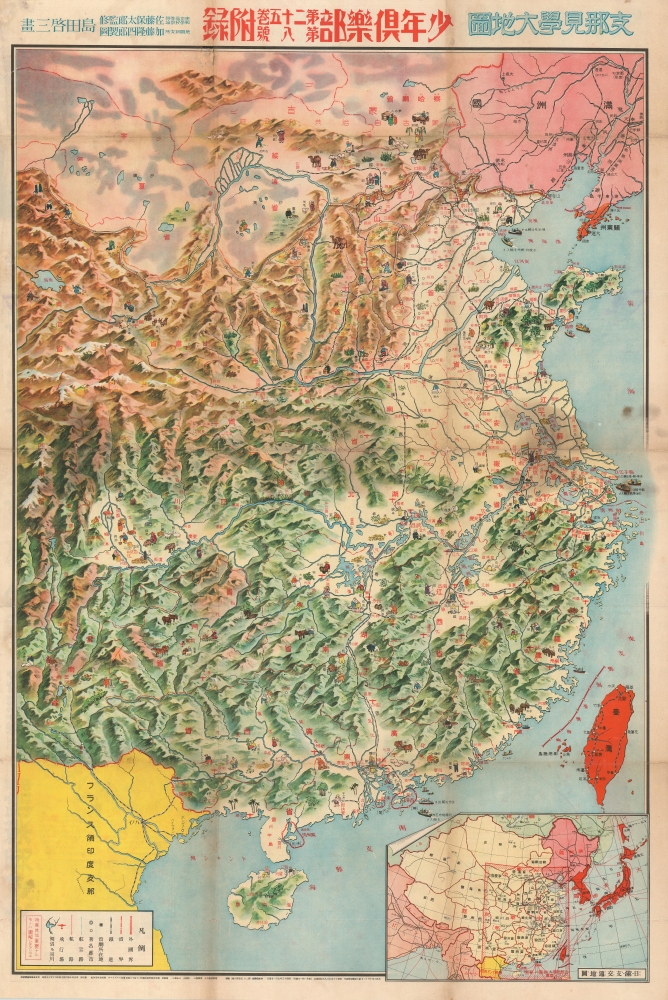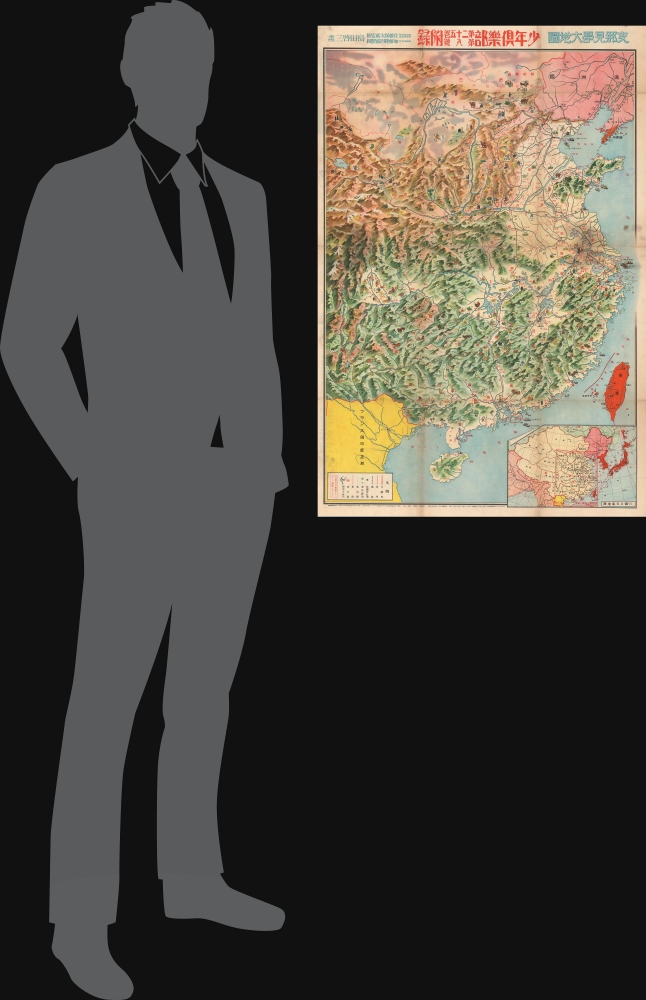This item has been sold, but you can get on the Waitlist to be notified if another example becomes available, or purchase a digital scan.
1938 Sato Manga or Cartoon WWII Propaganda Map of China
ChinaMangaMap-sato-1938
Title
1938 (dated) 36.26 x 24.5 in (92.1004 x 62.23 cm) 1 : 3400000
Description
Propaganda for Kids
The map is designed to lionize Japanese achievements during the 1937-1938 invasion of China. In Nanjing, recently the site of one of the worst atrocities of the war, a 'happy' Chinese man flies the quinta-color Chinese Republic National Flag (1912 - 1929), which had been replaced by the Guomindang-led Nanjing government and then revived by the Japanese to represent the puppet 'Reformed Nanjing government' (維新政府). In Beijing, a Japanese soldier holds a Chinese child who carries the Japanese flag. Nearby, a Chinese civilian holds the quinta-color puppet regime ensign. A simple legend notes the meaning of symbols on the map, while the main resources and industries in different parts of China are indicated. An inset at bottom-right shows the area covered in relation to the rest of East Asia. That this map was intended for Japanese schools indicates the increasing militarization of youth and popular culture in the early days of World War II.The Second Sino-Japanese War
The Second Sino-Japanese War was fought between the Republic of China, led by Chiang Kai-shek and the Guomindang (GMD, or Kuomintang KMT), and the Empire of Japan. Some scholars trace the beginning of the Second Sino-Japanese War to the Mukden Incident and the September 1931 Japanese invasion of Manchuria. In the following years, Japan established a puppet regime in Manchuria and extended its influence into northern China through several other 'incidents'. These 'incidents' led to Japan directly or indirectly controlling much of northern China and Inner Mongolia by 1937.Although determined to resist the Japanese, Chiang was eager to eliminate the domestic threat from the Communists first while also buying time to modernize his armies and gain better control over his generals, most of whom were semi-independent warlords. These plans were disrupted when Chiang was kidnapped by one of his own generals in December 1936 and forced to enter a united front with the Communists. Now forced to turn his attention towards a war with Japan, it was a matter not of if but when a war with Japan would come.
The July 7, 1937, Marco Polo Bridge Incident has traditionally been considered the start of the war when Chinese and Japanese troops began exchanging fire at the Marco Polo (Lugou) Bridge along a main access route to Beijing. This exchange of fire escalated to an all-out battle, leading to Japanese forces capturing both Beijing and its port city of Tianjin. As the conflict expanded, Chiang aimed to deliver a knockout blow before Japanese reserves could be thrown into the fight. He launched an assault on Shanghai in the autumn of 1937, hoping to throw the Japanese garrison there into the sea, but was unable to drive them out completely. When Japanese reinforcements did arrive, they launched a counterattack that forced Chiang to retreat from Shanghai with heavy losses. After a cursory defense of the capital, Nanjing, Chiang moved deep into the Chinese interior to prepare for a protracted war of attrition.
Slowing Japan's Advance
After their rapid victories at the start of the war, by mid-1938, Japan was reaching an impasse. Years of military modernization and propaganda had laid the groundwork for the successful first phase of the war, but Japan lacked the resources and manpower to occupy the vast territory of China. It was hoped that further victories and capture of major cities would force Chiang to surrender, so Japanese armies took city after city along the coast and down the Yangtze River. For its part, China had scored a surprise victory at the Battle of Tai'erzhuang in the spring of 1938, slowing Japan's advance, and engaged in grand-scale scorched earth tactics, most famously blowing up the dikes on the Yellow River, flooding thousands of kilometers of land, killing several hundred thousand civilians and Japanese troops, and restricting the possible paths of Japanese advance.Chiang set up a temporary headquarters in Hankou (Wuhan) while preparations were made in Chongqing. Japanese commanders hoped that another major victory would demoralize Chinese forces to the point that Chiang would surrender. With the extra time provided by the Yellow River floods, Chiang prepared a defense of Hankou and the wider middle Yangtze region. In June 1938, just before this map was published, the Japanese began their attack in earnest, quickly capturing Anqing, Jiujiang, and several strategically important railways. However, they ran into increasingly stiff resistance as the campaign wore on while also contending with guerilla attacks and surprise counter-attacks deep behind the front line. A campaign was also launched to cut off Chiang's supplies by invading and occupying Guangzhou, which diverted resources from the main battle near Hankou. In the end, the Japanese occupied both Hankou and Guangzhou, but at a high cost and without achieving their goal of forcing Chiang to surrender.
Youth Club and Kōdansha
Youth Club (少年倶樂部) was a monthly magazine for boys published from 1914 - 1962 by Dai Nippon Yūbenkai Kōdansha (大日本雄辯會講談社, now known simply as Kōdansha). It was an important contributor to the birth of mass youth culture in Japan. Along with Youth Club, Kōdansha published several other magazines, including Women's Club (婦人倶樂部) and King (キング). It had become a major shaper of Japanese culture and public opinion by the 1930s, controlling 70% of the magazine market.Founded by the dynamic Noma Seiji (野間淸治, 1878 - 1938), Kōdansha suffered difficulties during the war period due to both intense censorship and the death of both Noma Seiji and his son, Noma Hasashi (野間恒), within weeks of each other in 1938. Still, the company survived the wartime era and, after a period of difficulties during the U.S. Occupation due to Kōdansha's endorsement of militarism, benefitted from a postwar publishing revival. In 1962, Youth Club was merged with Kodansha's Weekly Youth Magazine (週刊少年マガジン), still one of Japan's flagship manga magazines.
Publication History and Census
This map was published as an addendum to Youth Club (小年俱樂部) magazine, Vol. 25 No. 8. It was drawn by Shimada Keizō (島田啓三), drafted by Kato Takashiro (加藤隆四郎), edited and published by Sutō Kenzō (須藤憲三) of Dai Nippon Yūbenkai Kōdansha (大日本雄辯會講談社), and printed by Ei Teizō (日永悌三) of Yukosha (株式會社有恆社). The process of producing the map was supervised by Satō Yūtarō (佐藤裕太郎), a teacher at the Tokyo Higher Normal School (東京高等師範學校). It was printed on June 8, 1938 (Showa 13) and issued on July 1. It is only known to be held by the National Museum of Taiwan History and is scarce to the market.CartographerS
Satō Yasutarō (佐藤裕太郎; March 5, 1893 – March 7, 1977), or Satō Yūtarō, was a Japanese educator active in Tokyo during the Taisho and Showa Eras. During and just prior to World War II, he worked with the Japanese Youth Club (少年俱樂部), a popular magazine which published several important manga maps of East Asia. After the war, Yasutarō became a professor at Tokyo University of Education and later, the the Senshu University. More by this mapmaker...
Kato Takashiro (加藤隆四郎, also read as Kato Ryūshirō; fl. c. 1930 - 1943) was a Japanese cartographer and illustrator who made several maps of China and Asia during World War II, often appearing in magazines published by Kodansha (講談社). Learn More...
Yukosha (株式會社有恆社; 1872 - 1943) was a Japanese paper manufacturing company and occasional publisher that existed in the Meiji and Taisho eras. In 1874, it was a pioneer in the Japanese paper industry, being the first company in Japan to produce Western-style paper, using an imported paper machine. Established in 1872 by the Asano family, the former lords of the Hiroshima domain, it was gradually absorbed by the Oji Paper Co. (王子製紙株式會社) between 1918 and 1924. Oji continued to operate Yukosha's mills until they were switched over to producing munitions during World War II and converted to other purposes after the war. Learn More...
Kodansha (式会社講談社, 1909 - Present), also known as Dai Nippon Odankai Kodansha, is a Japanese publishing house founded in 1909 by Seiji Noma (野間淸治). Seiji founded Kodansha as a spin-off from the Dai-Nippon Yūbenkai (Greater Japan Oratorical Society) and produced the literary magazine Yūben as its first publication. The name Kodansha, a derivative of the defunct magazine Kōdan Club (Storytelling Club), in 1911, which it merged with the Dai-Nippon Yūbenkai. In 1925, Kodansha launched King (キング) , the first magazine to sell 1,000,000 copies in its first printing. Kōdansha published several other magazines including Women's Club (婦人倶樂部) and Boy's Club (少年倶樂部) and had become a major shaper of Japanese culture and public opinion by the 1930s, controlling 70% of the magazine market. Kōdansha suffered difficulties during the war period, due to both intense censorship and the 1938 death of both Noma Seiji and his son, Noma Hasashi (野間恒), within weeks of one another. Still, the company survived the wartime era and, after a period of difficulties during the U.S. Occupation due to Kōdansha's endorsement of militarism, benefitted from a postwar publishing revival. Although King and other magazines ceased publication in the postwar period, Kōdansha branched into other areas, including manga and music recording, and is now the largest publisher in Japan. Learn More...
Keizo Shimada (島田 啓三; May 3, 1900 - 1973) was an early Japanese mangaka (漫画家), best known for his comic The Adventures of Dankichi, serialized in Youth Club (小年俱樂部) magazine, published by Dai Nippon Yūbenkai Kōdansha (大日本雄辯會講談社). The comic, based around the adventures of a young boy shipwrecked on a remote island in the South Pacific, was similar to The Adventures of Tintin. Like Tintin, it was later criticized for celebrating imperialism and denigrating other races. Dankichi also resembled its contemporary, another pioneering manga, Tagawa Suihō's Norakuro, in that both became a tool for propaganda during the Second Sino-Japanese War (World War II). Learn More...




